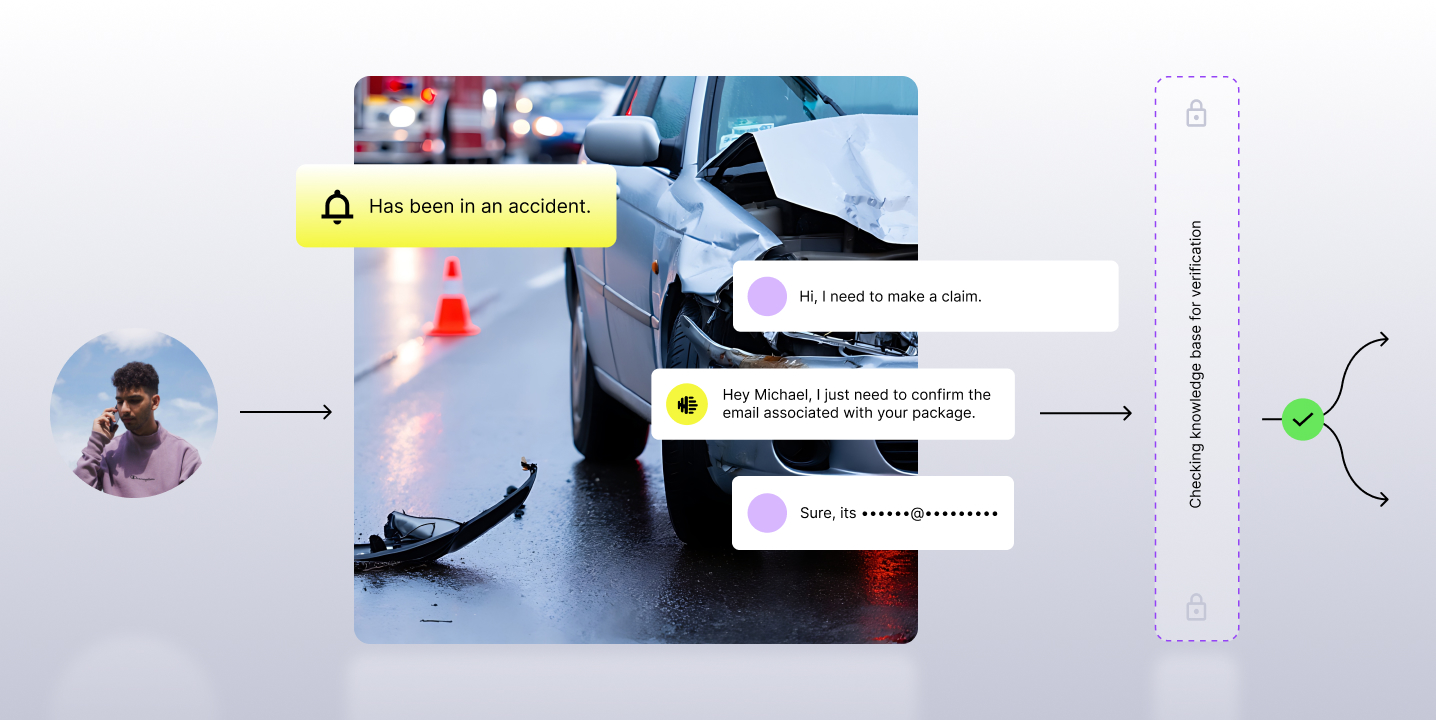This is a guest post from Knowmax, a self-service, centralized information repository for incorporating and organizing information of enterprises.
Today’s global contact centers are looking at new operating models. Recent transformations include the shift to remote work, mobile-based CRM solutions, and rapid adoption of platforms and apps that enable customers to “own their experience” through self-service.
It seems that enterprises today are taking every possible step to reduce operating costs while delivering more and better customer experiences.
While doing more with less bring advantages, it can fall flat if not executed correctly. For example, in a compliance-driven industry like banking or insurance, sensitive and private customer information must not be compromised, and proper compliance monitoring and mitigation must be in place.
That’s where AI-based technologies like knowledge management and contact center AI software come into play.
.png)
First, what is AI-based knowledge management?
AI-based knowledge management uses machine learning, natural language processing and semantic search that identifies keywords related to customer concerns and immediately empowers support agents with relevant knowledge articles.
This reduces the effort in findability of information thus reducing agent error at contact centers and making sure key customer service metrics are achieved.

3 Benefits of AI-based Knowledge Management
1. It Provides a Single Source of Truth
It’s critical to drive a culture of organized knowledge and information from the beginning. If you haven’t established that yet, with agents working remotely, that’s the first thing you should tackle.
Information overload is a major challenge in today’s world, and difficulties finding and acting on the right information just adds on to it. Enterprises should manage a unified repository for both internal and external customers, which can be leveraged during any stage of the customer lifecycle.
You don’t have to recreate content and in many cases, can reuse the same content on different channels, while continuing to create versions to keep your contact center knowledge up to date.

2. Improves Standard Operating Procedure Adherence
We’ve seen time and time again that customers get different answers from different agents, and get stuck in a never-ending loop. I’ve personally seen CX leaders frustrated with low customer satisfaction (CSAT) and first call resolution (FCR) numbers, along with the pressure of a high average handle time (AHT) and overall opex costs.
Taking a step back and conducting a root cause analysis (RCA), teams might discover that the agent ended up giving the customer incorrect information. Especially with remote workforces, agents can’t put customers on hold, walk down the contact center floor, and get immediate help from a supervisor or subject matter expert (SME) to resolve complex customer queries.
3. Builds Culture Through Collaboration
Agents are the lifeblood of a contact center, interacting with customers daily. Their opinion and feedback is incredibly valuable. Imagine having an outdated workflow or process still in place when policies have changed.
Agents can quickly highlight issues and authors can rapidly update information. At the same time, teams are able to gather insights on top-ranking content and useful articles across the call center, looking at what agents and teams engage with what assets.
Additionally, they can also find alternate mediums to proactively educate customers around how to own their experience and reduce repeat calls, particularly around less-complex queries. This enables support agents to invest time on more complex queries and building healthier relationships with consumers.

What is contact center AI?
To better monitor performance, customer experience, and the operational efficiency of a remote workforce, organizations are turning to AI-enabled technologies. That includes technologies like speech analytics and contact center AI.
Contact center AI brings together speech analytics and quality management in a single platform to transform the customer support experience. It empowers organizations to:
- Transcribe and analyze 100% of voice calls for call quality and compliance.
- Deliver deep insights to evaluate agent performance.
- Provide data-driven, targeted coaching to agents.
The result is significant improvements in compliance monitoring, agent performance and the overall customer experience.
With contact center AI, organizations get deep metrics on major call center KPIs like AHT, supervisor escalations, and sentiment. They can surface these insights across organizations, business lines, and down to the individual agents to know what’s happening on every call. This answers questions like:
- Are agents adopting new messaging?
- Are new processes being followed appropriately?
- What are top agents saying and doing to display empathy or improve sentiment on calls?
Who Uses contact center AI?
- Operations Leaders and Customer Experience Leaders analyze 100% of voice calls to derive insights and in turn, drive efficiencies across the organization.
- Supervisors and Trainers, specifically in Learning and Development turn their agents into top performers with more relevant and interactive coaching programs.
- Quality Analysts utilize speech analytics and quality management tools to monitor for CSAT and compliance interactions and influence agent coaching.
- Agents receive transparent, data-driven, and objective feedback.
How contact center AI Amplifies Knowledge Management
1. Don’t Just Record, But Monitor 100% of Calls
We’ve all heard the phrase this call will be recorded for training and monitoring purposes. Yet in reality, how many of these calls are actually listened by quality analysts? Typically, just 1-2%, or even less.
Once a call is monitored, complexities arise in the feedback loop as quality analysts and supervisors juggle multiple platforms and spreadsheets to evaluate calls, score interactions, and change agent behavior.
That’s where contact center AI comes into the picture. If you use AI to surface the most meaningful interactions and points of interest in calls, you enable the team to evaluate more calls at higher quality. In turn, supervisors can coach with the why and provide the context and data agents need to change key behaviors.

2. Get a More Holistic, Unbiased View of Contact Center KPIs
From using proper openers, to confirming that teams follow standard operating procedures on voice calls, contact center AI can take the guesswork out of your quality management process.
For example, with contact center AI teams can easily identify dead air, which may indicate a lack of agent confidence or training. It can also identify hold time violations, negative or positive sentiment, supervisor escalations, and more.
By flagging these instances of polarity on calls, agents can be offered tailored coaching and empowered to handle tougher situations in an effective manner.

3. Coach On the “Why” and Spot Business Trends
Contact center leadership is hungry for insights to drive improvements and quantify strategies that can be capitalized on.
With contact center AI, these leaders can search for keywords and critical interactions across every call to identify common trends that emerge, and gain context behind what might be causing them.
Rather than relying on assumptions, teams can operate on context and data-backed conclusions. In turn, they can more effectively coach agents on how to identify and address unmet needs, like requests for products and services that could be provided in the future, or new locations the business could operate in.
The One-Two Punch: Contact Center AI & Knowledge Management
Merging contact center AI and Knowledge Management creates an agile workflow, completely designed to improve every customer interaction and every agent on the team.
Let’s look at a real life example.
Imagine you’ve got an upset customer calling about an incorrect credit card charge. Contact center AI captures what the customer is saying and determines negative sentiment on the call. At the same time, Knowledge Management can be accessed to surface a decision tree of the proper protocol to take to solve this customer complaint.
The customer begins to feel better as the agent shares the proper information, but then asks a question that the agent doesn’t know how to respond. Contact center AI records the hesitancy and identifies Dead Air.
Eventually, the agent is able to bring in their supervisor and resolve the query. They’re also able to provide feedback via their Knowledge Management System that a particular resource needs to be updated.
- Operator Action: At the same time, the operator of the contact center can see with contact center AI that this particular challenge on calls about incorrect credit card charges is driving up negative sentiment and Dead Air. WIth context, they can put new protocols in place.
- Supervisor Action: Supervisors can access an agent leaderboard to identify that this agent has a challenge with long periods of Dead Air and coach them on some techniques to try with customers when they don’t know the answer immediately.
That is how the contact centers of the future will operate, and increasingly in realtime as they augment agents on live calls with the right resources and the right time that are surfaced based on speech recognition.
Then, agents can deeply listen, and teams can continue to invest in training and improving their frontline brand representatives -- the only people who in many instances today truly humanize and help customers build an emotional relationship with their brand.
















